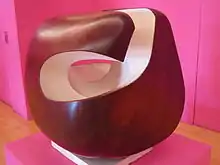Guarea
Guarea is a genus of evergreen trees or shrubs in the family Meliaceae, native to tropical Africa and Central and South America. At their largest, they are large trees 20–45 m tall, with a trunk over 1 m diameter, often buttressed at the base. The leaves are pinnate, with 4–6 pairs of leaflets, the terminal leaflet present. They are dioecious, with male and female flowers on separate plants.[1] The flowers are produced in loose inflorescences, each flower small, with 4–5 yellowish petals. The fruit is a four or five-valved capsule, containing several seeds, each surrounded by a yellow-orange fleshy aril; the seeds are dispersed by hornbills and monkeys which eat the aril.
| Guarea | |
|---|---|
 | |
| Guarea guidonia | |
| Scientific classification | |
| Kingdom: | Plantae |
| Clade: | Tracheophytes |
| Clade: | Angiosperms |
| Clade: | Eudicots |
| Clade: | Rosids |
| Order: | Sapindales |
| Family: | Meliaceae |
| Subfamily: | Melioideae |
| Genus: | Guarea F. Allam ex L. |
| Species | |
|
See text | |
Species
Species accepted by Plants of the World Online as of March 2019:[2]
- Guarea aguilarii Al.Rodr.
- Guarea anomala T.D.Penn.
- Guarea bijuga C.DC.
- Guarea blanchetii C.DC.
- Guarea bullata Radlk.
- Guarea carapoides Harms
- Guarea carinata Ducke
- Guarea cartaguenya Cuatrec.
- Guarea casimiriana Harms
- Guarea caulobotrys Cuatrec. (also spelt caulobotryis)
- Guarea chiricana Standl.
- Guarea cinnamomea Harms
- Guarea constricta Al.Rodr.
- Guarea convergens T.D.Penn.
- Guarea corrugata Cuatrec.
- Guarea corticosa Al.Rodr.
- Guarea costata A.Juss.
- Guarea crispa T.D.Penn.
- Guarea cristata T.D.Penn.
- Guarea donnell-smithii C.DC.
- Guarea ecuadoriensis W.Palacios
- Guarea eriorhachis Harms
- Guarea fissicalyx Harms
- Guarea fistulosa W.Palacios
- Guarea gentryi Coronado
- Guarea glabra Vahl
- Guarea gomma Pulle
- Guarea gracilis T.D.Penn.
- Guarea grossa T.D.Penn.
- Guarea guentheri Harms
- Guarea guidonia (L.) Sleumer
- Guarea hoffmanniana C.DC.
- Guarea humaitensis T.D.Penn.
- Guarea inesiana Al.Rodr.
- Guarea jamaicensis Proctor
- Guarea juglandiformis T.D.Penn.
- Guarea kunthiana A.Juss.
- Guarea lozanoi Morales-P.
- Guarea luxii C.DC.
- Guarea macrocalyx Al.Rodr.
- Guarea macrophylla Vahl
- Guarea megacostata T.D.Penn.
- Guarea megantha A.Juss.
- Guarea mexicana Coronado
- Guarea michel-moddei T.D.Penn. & S.A.Mori
- Guarea pendula R.da Silva Ramalho, A.L.Pinheiro & T.D.Penn.
- Guarea persistens W.Palacios
- Guarea polymera Little
- Guarea pterorhachis Harms
- Guarea pubescens (Rich.) A.Juss.
- Guarea purusana C.DC.
- Guarea pyriformis T.D.Penn.
- Guarea reticulatovenosa T.D.Penn.
- Guarea rhopalocarpa Radlk.
- Guarea riparia W.Palacios
- Guarea scabra A.Juss.
- Guarea silvatica C.DC.
- Guarea sphenophylla Urb.
- Guarea sprucei C.DC.
- Guarea subandina W.Palacios
- Guarea subsessilifolia Al.Rodr.
- Guarea tafae-malekui Al.Rodr.
- Guarea talamancana Gómez-Laur. & Valerio
- Guarea tonduzii C.DC.
- Guarea trunciflora C.DC.
- Guarea velutina A.Juss.
- Guarea venenata T.D.Penn.
- Guarea zarceroensis Coronado
- Guarea zepivae T.D.Penn.
Uses
The timber is important; the African species are known as bossé, guarea, or pink mahogany, and the South American species as cramantee or American muskwood. It is said to possibly cause hallucinations if ingested.[3]

The wood can be used for sculpture and was favoured by the British 20th century sculptor Barbara Hepworth.[4]
References
- Pennington, T. D.; Styles, B. T. (1975). "A Generic Monograph of the Meliaceae". Blumea. 22: 419–540.
- "Guarea". Plants of the World Online. Royal Botanic Gardens, Kew. 2017. Retrieved 17 March 2019.
- "Scientists get dirt on mystery plant". STLtoday.com. 5 May 2009. Archived from the original on 16 June 2009. Retrieved 2009-05-07.
{{cite web}}: External link in|publisher= - "Corinthos 1954–5". UK: Tate Gallery. Retrieved 5 August 2015.